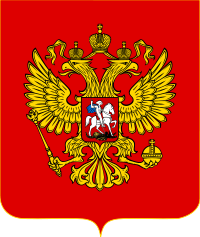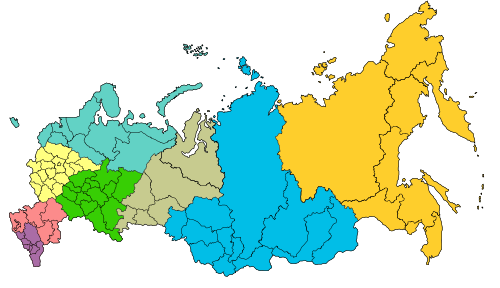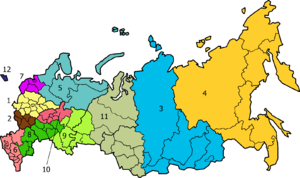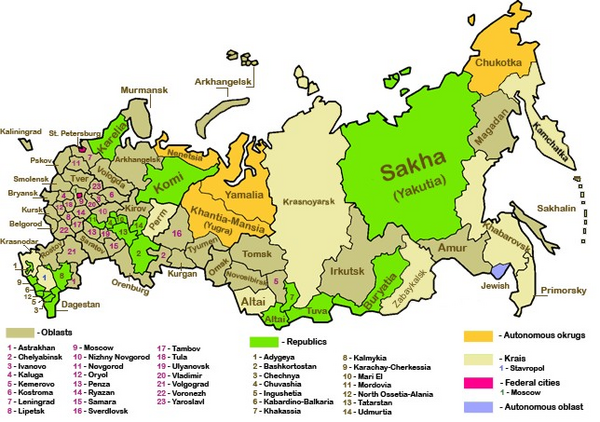Subdivisions of Russia
| Russia |
 This article is part of the series: |
|
|
Presidency
Legislature
Judiciary
Political parties
Elections
Other issues
|
|
Other countries · Atlas |
Being the largest country in the world and constituting a large percentage of area and population of Eurasia, Russia is divided into several types and levels of subdivisions.
Contents |
Federal subjects
Russia is a federation which since March 1, 2008 consists of 83 federal subjects (members of the Federation).[1] These federal subjects are of equal federal rights in the sense that they have equal representation—two delegates each—in the Federation Council (upper house of the Federal Assembly). They do, however, differ in the degree of autonomy they enjoy.
Six types of federal subjects are distinguished—21 republics, 9 krais, 46 oblasts, 2 federal cities, 1 autonomous oblast, and 4 autonomous okrugs.
Autonomous okrugs are the only ones that have a peculiar status of being federal subjects in their own right, yet at the same time they are considered to be administrative divisions of other federal subjects (with Chukotka Autonomous Okrug being the only exception).
Administrative divisions
The administrative and territorial division of each federal subject is developed and maintained separately by each federal subject and can vary significantly from one federal subject to another. In general, however, the following types of high-level administrative divisions exist in most federal subjects:
- Raions (administrative districts)
- Cities/towns and urban-type settlements under the jurisdiction of the federal subject
Other types of high-level administrative divisions include:
- Autonomous okrugs under the jurisdiction of another federal subject are still constitutionally recognized as federal subjects on their own right. Administratively, they can also be divided into raions and cities/towns/urban-type settlements under the jurisdiction of the autonomous okrug.
- Okrugs, which are former autonomous okrugs merged into other federal subjects.
Typical lower level administrative divisions include:
- Selsoviets (rural councils)
- Towns and urban-type settlements under the jurisdiction of the administrative district
- City districts
|
||||||||||||||||||||||
Municipal divisions
In the course of the Russian municipal reform of 2004–2005, all federal subjects of Russia were to streamline the structures of the local self-government, which is guaranteed by the Constitution of Russia. The reform prescribed that each federal subject have a unified structure of the municipal government bodies by January 1, 2005, and a law enforcing the reform provisions went in effect on January 1, 2006. According to the law, the units of the municipal division (called "municipal formations") are as follows:
- Municipal district, a group of urban and rural settlements, often along with the inter-settlement territories. In practice, municipal districts are usually formed within the boundaries of existing administrative districts (raions).
- Urban settlement, a city/town or an urban-type settlement, possibly together with adjacent rural and/or urban localities
- Rural settlement, one or several rural localities
- Urban okrug, an urban settlement not incorporated into a municipal district
- Intra-city territory of a federal city, a part of a federal city's territory. In Moscow, these are called districts (raions); in St. Petersburg—municipal okrugs, towns, and settlements.
Territories not included as a part of municipal formations are known as inter-settlement territories.
Other types of subdivisions
Federal districts

All of the federal subjects are grouped into eight federal districts,[2] each administered by an envoy appointed by the President of Russia. Federal districts' envoys serve as liaisons between the federal subjects and the federal government and are primarily responsible for overseeing the compliance of the federal subjects with the federal laws.
Economic regions

For economic and statistical purposes the federal subjects are grouped into twelve economic regions.[3] Economic regions and their parts sharing common economic trends are in turn grouped into economic zones and macrozones.
See also
- History of the administrative division of Russia
- List of federal subjects of Russia by area
- List of federal subjects of Russia by population
- Types of inhabited localities in Russia
References
- ↑ Constitution, Article 65
- ↑ Президент Российской Федерации. Указ №849 от 13 мая 2000 г. «О полномочном представителе Президента Российской Федерации в федеральном округе». Вступил в силу 13 мая 2000 г. Опубликован: "Собрание законодательства РФ", №20, ст. 2112, 15 мая 2000 г. (President of the Russian Federation. Decree #849 of May 13, 2000 On the Plenipotentiary Representative of the President of the Russian Federation in a Federal District. Effective as of May 13, 2000).
- ↑ "Общероссийский классификатор экономических регионов" (ОК 024-95) введённый 1 января 1997 г., в ред. Изменения № 05/2001. Секция II. Экономические районы (Russian Classificaton of Economic Regions (OK 024-95) of January 1, 1997 as amended by the Amendments #1/1998 through #5/2001. Section II. Economic Regions)
Sources
- 12 декабря 1993 г. «Конституция Российской Федерации», в ред. Федерального конституционного закона №7-ФКЗ от 30 декабря 2008 г. Вступил в силу со дня официального опубликования. Опубликован: "Российская газета", №237, 25 декабря 1993 г. (December 12, 1993 Constitution of the Russian Federation, as amended by the Federal Constitutional Law #7-FKZ of December 30, 2008. Effective as of the official publication date).
External links
|
|||||||||||||||||||||||||||||
|
|||||
|
||||||||||||||
